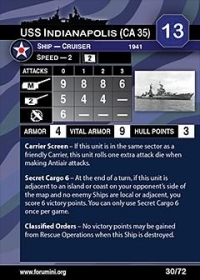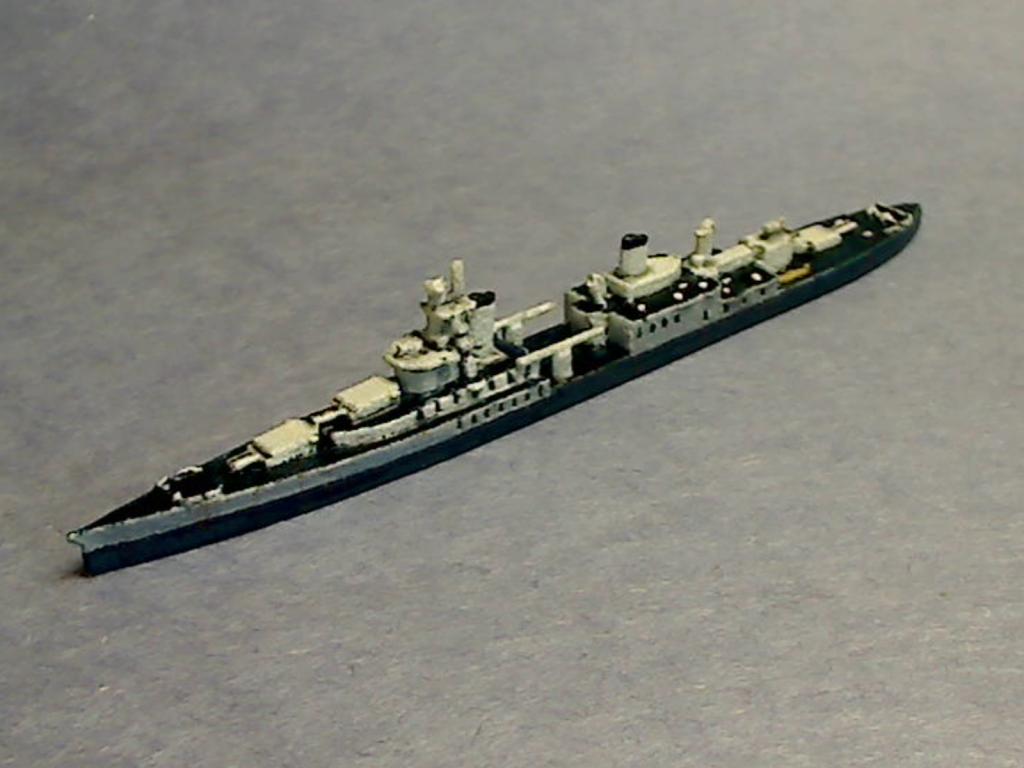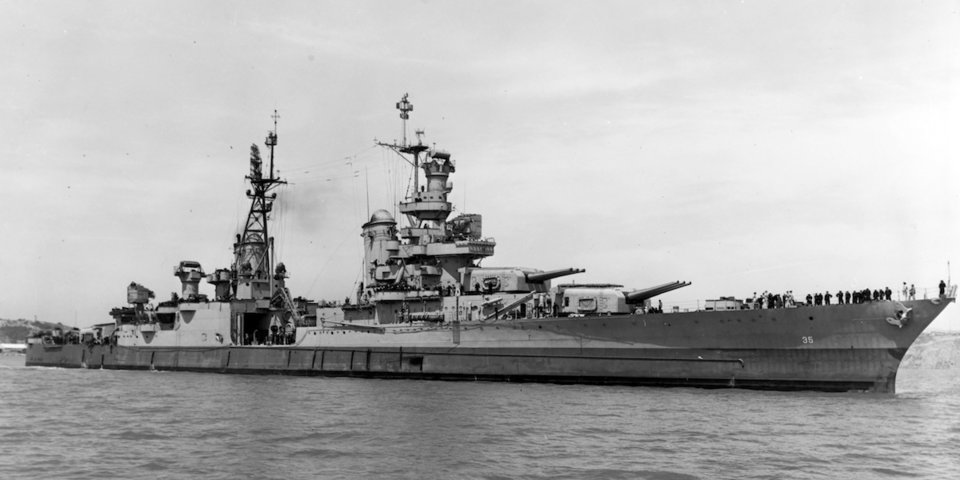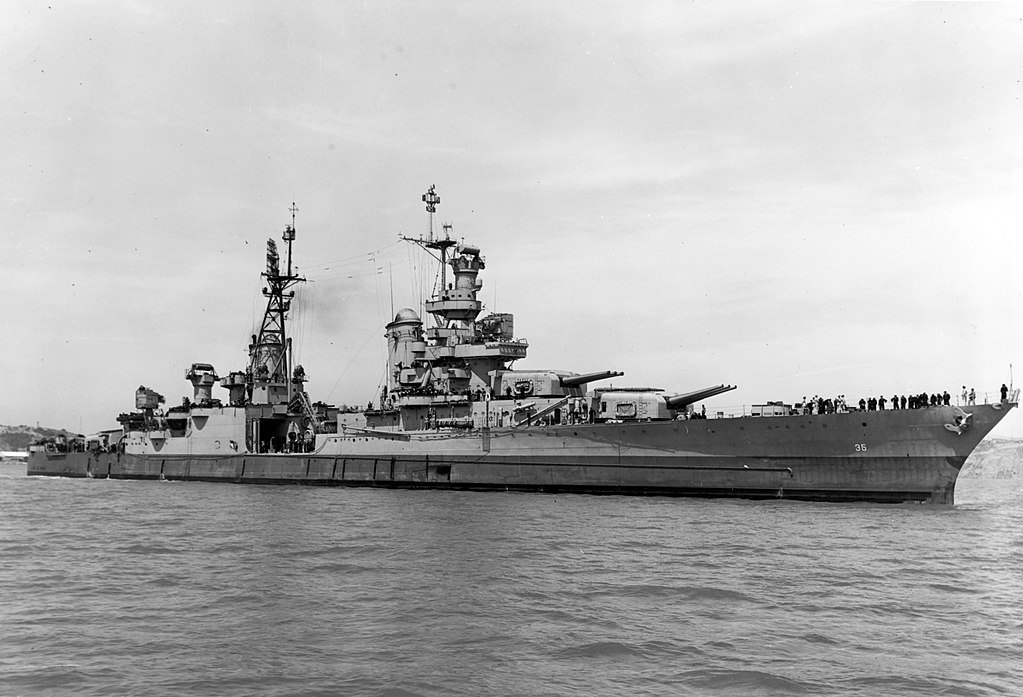Prototype: USS Indianapolis (CA-35) was a Portland-class heavy cruiser of the United States Navy that was sunk in 1945. The ship was famous for tragic loss of life surrounding the sinking of this ship. At the time of its loss, the ship was crewed by 1,195 sailors. Only 316 of these men survived to be rescued.
Although it has been claimed that the secret nature of its prior mission (the deliver of an atomic bomb yo the Air Force base at Tinian) prevented active search and rescue operations from being attempted, it is more commonly accepted that nobody bothered to questions where she was when she failed to arrive at the Philippines as scheduled.
July of 1945 was a chaotic time in the Pacific War. The US Navy was coordinating 100s of capital ships across a theater that spanned millions of square miles. One might think it is kind of hard to lose something as large as a heavy cruiser, but it is easy to forget that the Navy was in the process of preparing for Operation Olympic, the amphibious invasion of the Japanese home islands, and the millions of soldiers were being moved all over the Pacific in preparation for the attack. So yes, one can easily imagine that a few ships could easily not end up being quite where they were expected to be. This was especially true for an older ship such as a Portland class cruiser built in the 1930s which may or may not have had any number of mechanical issues as well as a whole slew of challenges with the various upgraded components and refits she had see over the preceding 15 years. That being said, it was somebody's job to know where this cruiser was, and when it was hit by two Japanese torpedoes on the 30th of July, 1945 that person should have started screaming bloody murder when CA-35 failed to show up at Leyte on July 31. Because nobody bothered to make a stink about the late arrival, approximately 1000 men had to die as resu;t of exposure, shark attacks, dehydration and saltwater poisoning. Not only did this event result in the single greatest loss of life at sea from a single ship in US history, but the nature of the violence and horror inflicted upon these men will forever serve as a reminder to all Americans of the sacrifices made by these men for our freedom.
Although it has been claimed that the secret nature of its prior mission (the deliver of an atomic bomb yo the Air Force base at Tinian) prevented active search and rescue operations from being attempted, it is more commonly accepted that nobody bothered to questions where she was when she failed to arrive at the Philippines as scheduled.
July of 1945 was a chaotic time in the Pacific War. The US Navy was coordinating 100s of capital ships across a theater that spanned millions of square miles. One might think it is kind of hard to lose something as large as a heavy cruiser, but it is easy to forget that the Navy was in the process of preparing for Operation Olympic, the amphibious invasion of the Japanese home islands, and the millions of soldiers were being moved all over the Pacific in preparation for the attack. So yes, one can easily imagine that a few ships could easily not end up being quite where they were expected to be. This was especially true for an older ship such as a Portland class cruiser built in the 1930s which may or may not have had any number of mechanical issues as well as a whole slew of challenges with the various upgraded components and refits she had see over the preceding 15 years. That being said, it was somebody's job to know where this cruiser was, and when it was hit by two Japanese torpedoes on the 30th of July, 1945 that person should have started screaming bloody murder when CA-35 failed to show up at Leyte on July 31. Because nobody bothered to make a stink about the late arrival, approximately 1000 men had to die as resu;t of exposure, shark attacks, dehydration and saltwater poisoning. Not only did this event result in the single greatest loss of life at sea from a single ship in US history, but the nature of the violence and horror inflicted upon these men will forever serve as a reminder to all Americans of the sacrifices made by these men for our freedom.
Class History: The Portland-class of heavy cruisers was a class of ships designed and constructed by the United States Navy in 1930. The two ships of the class, USS Portland (CA-33) and USS Indianapolis (CA-35) saw extensive service during the Pacific War in World War II.
Designed as a modification over the previous Northampton class cruiser, the Portland-class displaced just under 10,000 long tons (10,000 t) and featured heavier armor and armament than previous cruisers. Featuring 8"/55 caliber guns and designed to function as fleet flagships, the Portland-class were intended to fix problems with armament and armor that had been a weakness of preceding U.S. cruisers. These designs were carried over to the following New Orleans class, of which several Portland cruisers were converted to mid-construction.
Portland served in a large number of engagements including the Battle of Coral Sea, the Battle of Midway and the Guadalcanal Campaign, where she was severely damaged but nonetheless able to return to service. She later fought in the Battle of Leyte Gulf and the Battle of Okinawa. Indianapolis served as a fleet flagship for much of the war and fought in the Battle of Philippine Sea and the Battle of Iwo Jima. On 30 July 1945, after transporting components for the nuclear weapons Little Boy and Fat Man from the United States, she was torpedoed by the Japanese submarine I-58. Due to a series of errors and miscommunications her loss was not discovered for several days, and only 316 of her 1,116 crew survived.
Designed as a modification over the previous Northampton class cruiser, the Portland-class displaced just under 10,000 long tons (10,000 t) and featured heavier armor and armament than previous cruisers. Featuring 8"/55 caliber guns and designed to function as fleet flagships, the Portland-class were intended to fix problems with armament and armor that had been a weakness of preceding U.S. cruisers. These designs were carried over to the following New Orleans class, of which several Portland cruisers were converted to mid-construction.
Portland served in a large number of engagements including the Battle of Coral Sea, the Battle of Midway and the Guadalcanal Campaign, where she was severely damaged but nonetheless able to return to service. She later fought in the Battle of Leyte Gulf and the Battle of Okinawa. Indianapolis served as a fleet flagship for much of the war and fought in the Battle of Philippine Sea and the Battle of Iwo Jima. On 30 July 1945, after transporting components for the nuclear weapons Little Boy and Fat Man from the United States, she was torpedoed by the Japanese submarine I-58. Due to a series of errors and miscommunications her loss was not discovered for several days, and only 316 of her 1,116 crew survived.
Country: The U.S. is a country of 50 states covering a vast swath of North America, with Alaska in the northwest and Hawaii extending the nation’s presence into the Pacific Ocean. Major Atlantic Coast cities are New York, a global finance and culture center, and capital Washington, DC. Midwestern metropolis Chicago is known for influential architecture and on the west coast, Los Angeles' Hollywood is famed for filmmaking.
Item created by: Lethe on 2015-05-31 17:46:30. Last edited by gdm on 2019-08-24 15:46:30
If you see errors or missing data in this entry, please feel free to log in and edit it. Anyone with a Gmail account can log in instantly.
If you see errors or missing data in this entry, please feel free to log in and edit it. Anyone with a Gmail account can log in instantly.











